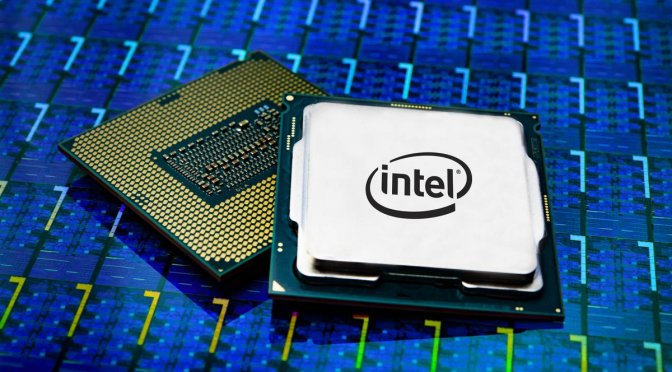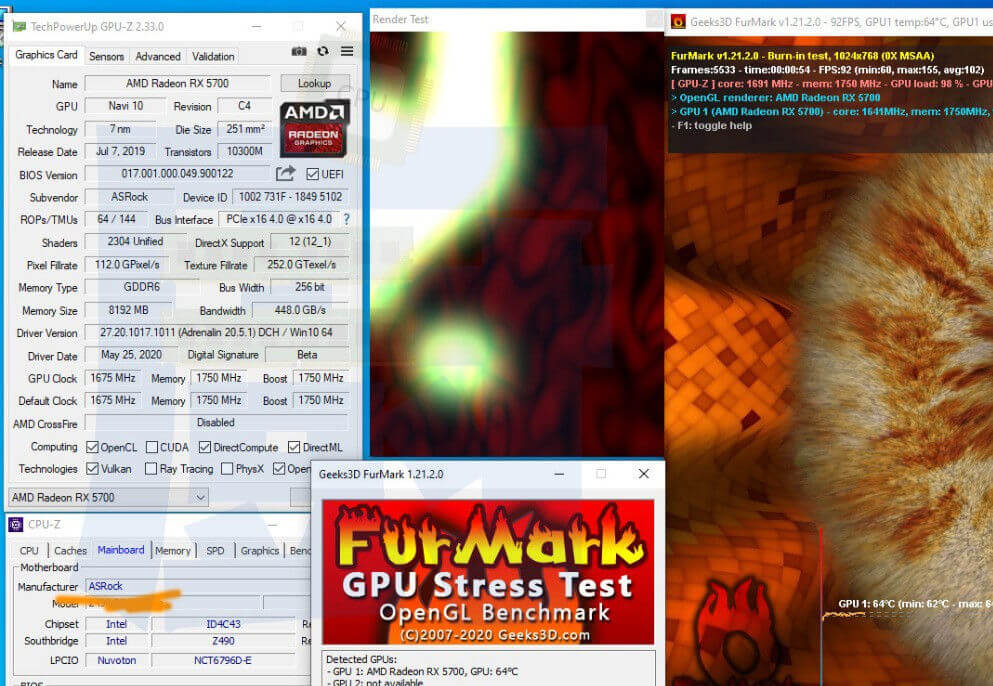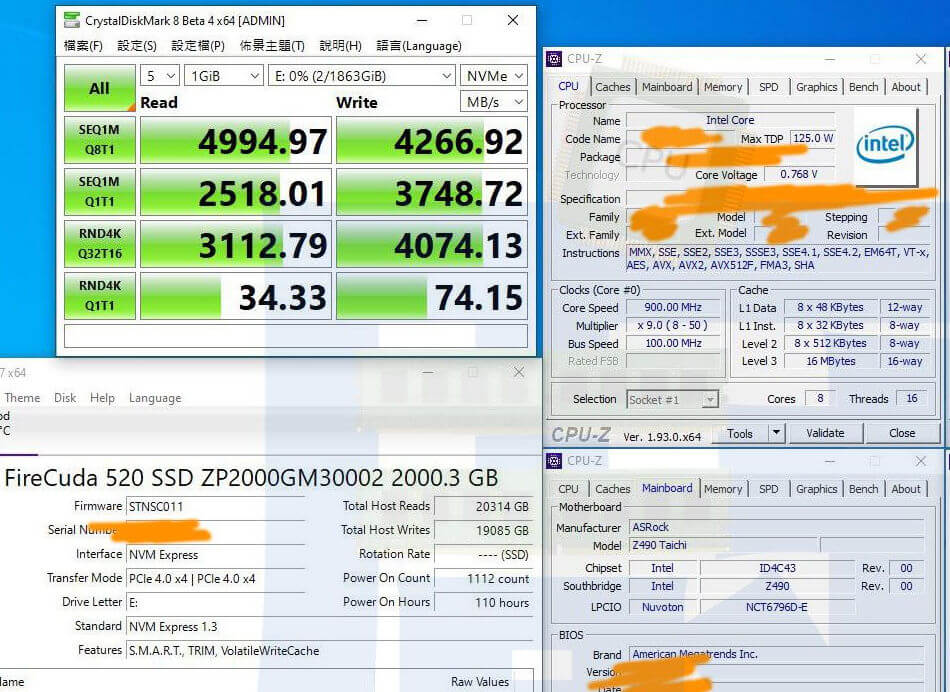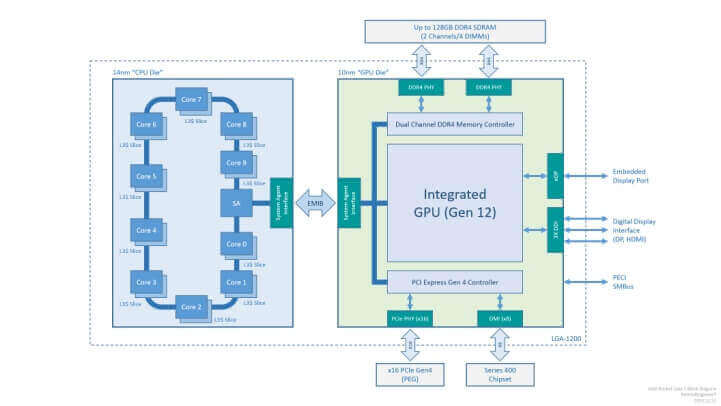Rocket Lake (RKL) is a planned microarchitecture designed by Intel as a direct successor to the Comet Lake-S series of desktop CPUs and high-performance mobile devices. Intel has been using the same iteration of the 14nm FinFET process node with the Skylake Architecture for many years. Comet Lake-S was also fabbed on this aging process node, which has held Intel back in terms of IPC uplift and efficiency gains over AMD’s Ryzen lineup.
Rocket Lake-S desktop platform is going to be the last CPU architecture to be based on an advanced 14nm process node. Intel’s Rocket Lake will use a 14++ nm back-port of the ‘Willow Cove/ Cypress’ core architecture. Rocket Lake is going to be the desktop equivalent of Tiger Lake.
Rocket Lake-S will be housed on 500-series motherboards. Although the Rocket Lake-S lineup will be the last to feature the LGA1200 socket/ Z490 chipset, Intel is planning a full range of chipsets, including workstation W580, high-end gaming Z590, H570 and budget-oriented B560 and H510 series. According to one recent roadmap, the gaming 500 mobo series is due to launch in late March, next year 2021.
Rocket Lake CPU lineup is currently planned for release in the first quarter of 2021, as confirmed by Intel on its official blog recently.
John Bonini (VP and GM of Client Computing Group Desktop, Workstation, and Gaming at Intel) also confirmed that the 11th Gen Core series processors codenamed Rocket Lake will be Intel’s first lineup to support the PCI-Express gen 4.0 interface, a feature which has been seemingly missing in Intel’s client Desktop CPU platform for quite some time.
Rocket lake-S CPUs are going to support the PCIe 4.0 standard and interface. Now one Taiwanese tech publication ITCooker has tested a Rocket Lake CPU sample on the Z490 Motherboard to check the platform’s PCIe-4.0 capabilities. The Rocket Lake S sample was tested with a PCIe 4.0 NVME SSD drive and an RX 5700 XT GPU.
For context, Intel’s 10th generation Comet Lake-S series of processors do not fully support this new PCIe 4.0 standard. But since hardware-level support for PCIe 4.0 is already built-in these Z490 boards, only Rocket Lake CPUs are going to offer full compatibility of the PCIe Gen 4.0 standard.
Several Motherboard vendors have also been advertising that their current Z490 boards are PCI-e 4.0-ready. PCIe 4.0 has been an AMD-only feature within the consumer market till now, but things might change with the launch of Rocket lake-S CPU lineup.
The benchmark was done using Seagate’s FireCuda 520 PCIE 4.0 drive, and AMD’s RX 5700 XT GPU. Both of these were recognized as proper PCIe 4.0-capable devices. CrystalDiskMark 8 software reported a read speed of 5 GB/s and a write speed of 4.2 GB/s (sequential), which is only possible on a PCIe 4.0 capable bus. And GPU-Z screen reports PCIe x16 4.0@ x16 4.0 active bus interface, when the AMD GPU was stress tested with Furmark software.
Both the SSD and GPU were properly using the PCIe Gen 4.0 standard on the Z490 platform. To quote ITCooker, via Google translation:
- INTEL Next Generation CPU can use Z490 line PCIE 4.0
- Fortunately, some Taiwanese friends borrowed PCIE 4.0 SSD for testing
- AMD 5700 XT is used for PCIE 4.0 but CPUZ cannot read memory
- After that, I’ll have a chance to test the super frequency again
The Rocket Lake CPU series will feature Intel’s Xe-based Gen12 integrated graphics, offering twice the performance over Gen 9.5 graphics, along with 12bit AV1, HEVC and E2E compression. There is also support for DDR4 Memory, HDMI 2.0b, DisplayPort 1.4a, USB 3.2 Gen 2×2 (20G), new overclocking features, USB audio offload, Thunderbolt 4 and Wi-Fi 6.
Intel has also broadened the DMI interface, which connects the processor to the platform controller hub (PCH), from x4 to x8.
According to previous rumors Rocket Lake will deliver desktop users up to eight cores and sixteen threads on the high-end, which means two cores and four threads less than the current Comet Lake processor lineup. But the reduction in core count could also mean that Intel plans to rely on increased single-threaded performance, thus boosting overall system performance through single-threaded gains.
Single-threaded performance will help Intel to compete more in the CPU market segment, even if AMD can deliver higher core count SKUs. Not all applications or tasks are highly multi-threaded in nature, which makes the single-threaded performance all the more important.
Few months ago one VLSI engineer who goes by the name @Retired Engineer on Twitter, @chiakokhua, tweeted one of his old findings from November 2019 last year. According to him the upcoming Rocket Lake-S processors are going to feature ‘multi-chip modules/MCM’ of core and uncore GPU dies built on different silicon fabrication nodes.
This is speculation from his side, but he has a strong record of accurate prediction in the past, when he spoke about the 3rd gen Ryzen Matisse AM4 processors being multi-chip modules as well.
Apparently, it might be possible that Intel is also designing these socket LGA1200-based Rocket Lake processors to feature multi-chip modules, similar to Matisse in some way. According to the block diagram posted by @chiakokhua, we can see that the Rocket Lake-S architecture is a multi-chip module/MCM consisting of a 14nm die that holds the ‘CPU cores’; and a 10 nm die that holds the ‘uncore’ components.
But in the case of Rocket Lake the uncore die is more advanced that the CPU die. The CPU die is fabbed on a 14 nm node on Rocket Lake-S, which contains the Willow Cove CPU cores in this die, and a system agent, which are connected together by a Ring-bus interconnect. And the system agent connects to the 10nm uncore GPU die via EMIB.
The 10 nm GPU uncore die on the other hand features the Gen12 XE iGPU with up to 96 EUs, a dual-channel DDR4 memory controller, a PCI-Express 4.0 controller, as well as display and media engines. Rocket Lake-S MCM may provide a total of 20 or even 24 PCI-Express lanes, out of which 16 are assigned as PEG (PCI-Express Graphics), and 8 lanes are assigned as chipset bus. You can see the Block diagram as posted below.
Stay tuned for more!
Hello, my name is NICK Richardson. I’m an avid PC and tech fan since the good old days of RIVA TNT2, and 3DFX interactive “Voodoo” gaming cards. I love playing mostly First-person shooters, and I’m a die-hard fan of this FPS genre, since the good ‘old Doom and Wolfenstein days.
MUSIC has always been my passion/roots, but I started gaming “casually” when I was young on Nvidia’s GeForce3 series of cards. I’m by no means an avid or a hardcore gamer though, but I just love stuff related to the PC, Games, and technology in general. I’ve been involved with many indie Metal bands worldwide, and have helped them promote their albums in record labels. I’m a very broad-minded down to earth guy. MUSIC is my inner expression, and soul.
Contact: Email




